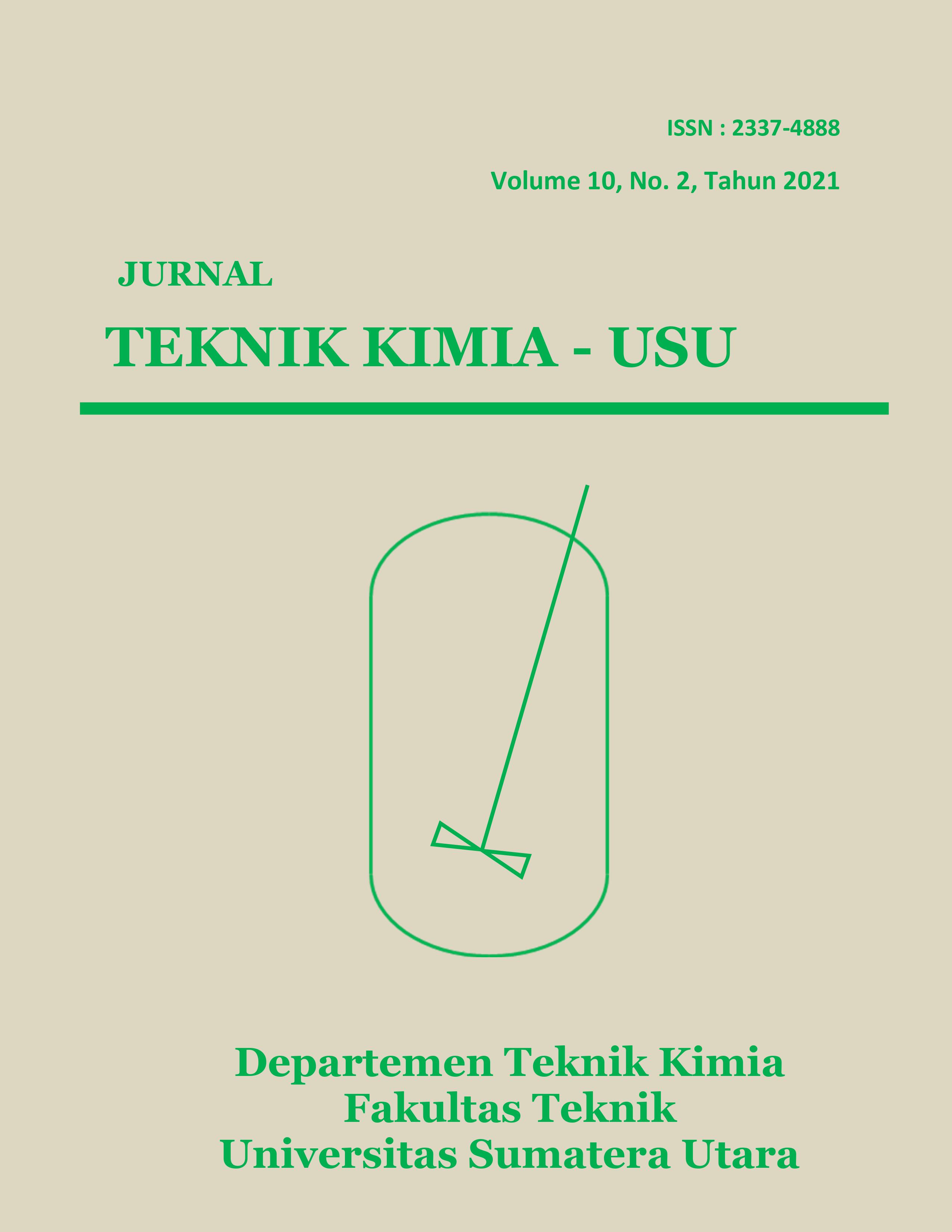Kinerja Aktivasi dan Impregnasi Fly Ash sebagai Adsorben Fenol
DOI:
https://doi.org/10.32734/jtk.v10i2.5883Keywords:
adsorption, activation, fly ash, phenol, impregnationAbstract
The purpose of this study was to determine the response and performance of fly ash as an adsorbent activated by HCl and impregnated with FeCl3 to absorb phenol. In this study, the fly ash activation process was carried out using 8 M HCl for 2 hours and impregnated with 2% FeCl3 for 2 hours. Activated and impregnated fly ash was analyzed using a Scanning Electron Microscope-Energy Dispersive Spectrophotometer (SEM-EDX). The results of the activated and impregnated fly ash surface using SEM-EDX showed that there were changes in morphology and functional groups. Then activated and impregnated fly ash was used to absorb phenol at a time variation of 60 minutes, 120 minutes, 180 minutes, 240 minutes and 300 minutes. At 180 minutes of contact time, the equilibrium point is obtained with an absorption efficiency of 90.5%. Second-order pseudo kinetics were used for phenol adsorption by Fe+ impregnated fly ash (R2 = 0.9916). The isotherm models used in the phenol adsorption process by fly ash impregnated with Fe+ are Langmuir Isotherm (R2 = 0.9927) and Freundlich Isotherm (R2 = 0.9984), which means that the adsorption process occurs in multi-layer and mono-layers.
Downloads
References
A. Jabbar, “Penyisihan fenol menggunakan kombinasi proses adsorpsi dan fotokatalisis pada reaktor skala pilotâ€, Skripsi, Universitas Indonesia, Depok, 2017.
S. Rengaraj, S. H. Moon, R. Sivabalan, B. Arabindoo, and V. Murugesan, “Removal of phenol from aqueous solution and resin manufacturing industry wastewater using an agricultural waste: Rubber seed coatâ€, J. Hazard. Mater., vol. 89, no. 2–3, pp. 185–196, 2002.
R. Sharan, G. Singh, and S. K. Gupta, “Adsorption of phenol from aqueous solution onto fly ash from a thermal power plant,†Adsorpt. Sci. Technol., vol. 27, no. 3, pp. 267–279, 2009.
B. G. Kutchko and A. G. Kim, “Fly ash characterization by SEM-EDS,†Fuel, vol. 85, no. 17–18, pp. 2537–2544, 2006.
H. Haspiadi, “Pemanfaatan abu terbang (Fly ash) batu bara sebagai campuran pembuatan bata beton,†J. Ris. Teknol. Ind., vol. 3, no. 6, 2016.
N. H. Haryanti, “Uji abu terbang PLTU asam asam sebagai bahan pembuatan bata ringan,†J. Fis. FLUX, vol. 11, no. 2, pp. 114–124, 2014.
A. S. M. Hosseini et al., “Synthesis of hydrous iron oxide/aluminum hydroxide composite loaded on coal fly ash as an effective mesoporous and low-cost sorbent for Cr (VI) sorption: Fuzzy Logic Modeling,†Asia Pacific Conference on Environmental Science and Technology (APEST 2012), vol. 6, pp.1-45, 2012.
N. Chaudhary, C. Balomajumder, B. Agrawal, and V. S. Jagati, “Removal of phenol using fly ash and impregnated fly ash: An approach to equilibrium, kinetic, and thermodynamic study,†Sep. Sci. Technol., vol. 50, no. 5, pp. 690–699, 2015.
B. Abussaud, H. A. Asmaly, A. Saleh, and V. Kumar, “Sorption of phenol from waters on activated carbon impregnated with iron oxide, aluminum oxide and titanium oxide,†J. Mol. Liq., 2015.
L. M. Barros Júnior, G. R. Macedo, M. M. L. Duarte, E. P. Silva, and A. K. C. L. Lobato, “Biosorption of cadmium using the fungus Aspergillus niger,†Brazilian J. Chem. Eng., vol. 20, no. 3, pp. 229–239, Sep. 2003.
M. Thripuranthaka et al., “Temperature dependent raman spectroscopy of chemically derived few layer MoS2 and WS2 nanosheets,†vol. 081911, 2014.
A. Sieczka and E. Koda, “Kinetic and equilibrium studies of sorption of ammonium in the soil-water environment in agricultural areas of central Poland,†Appl. Sci., vol. 6, no. 269, pp. 1-14, 2016.
Downloads
Published
Issue
Section
License
Copyright (c) 2021 Jurnal Teknik Kimia USU

This work is licensed under a Creative Commons Attribution-ShareAlike 4.0 International License.

















